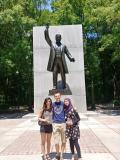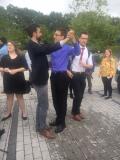Sunday, June 16, 2019
By:
If I seem a bit on edge, it’s because we just heated oven to 400 degrees Fahrenheit (or 477.6 K, for those of you with a thing for scientific units) and discovered that the plastic on certain objects does in fact begin to decompose at elevated temperatures. It’s a long story. Suffice it to say that we will go to great lengths to have a homemade pizza night (and that we’ll be looking for a different metal object to cover in tin foil and place in our oven. Maybe a pizza pan this time).
Before I get too distracted by talking about our continuing adventures, I’d better tell about my work week. I’m already waist-deep in data to analyze in MATLAB, but that’s a good problem to have: you never know what trends you’ll find, or what the physical interpretation of those trends can tell you. All of this data is coming from COMSOL, which is a very powerful computational tool for physics. It’s a coupled partial differential equation finite-element solver. That’s a mouthful, but it means it has the beautiful ability to reproduce reality given only the equations that are supposed to govern it. Of course, you still have to tell the program what your system looks like. You have to build it in three dimensions, assign materials and voltages to each domain, give them roles to play in the unfolding physics drama. There’s a certain amount of nuance to how you put it all together that I’m still just beginning to learn. But that’s the fun of learning, I suppose, and putting things together really was the theme of this week.
For example, I also got to play around with the microscope some more. On the one hand, I don’t really mean “playing”, since this advanced instrument is not a toy (and also wildly expensive). On the other hand, my mentor and I are going, you might say, off the map. This microscope technique requires different hardware, different inputs, than anything people have tried before to get a calibration signal[c]. There is no instruction manual. We’re going to be doing a lot of troubleshooting, testing, and, naturally, assembling.
Some really incredible events and outings once again took place this week, and I wish I could describe them all but then we’d have not so much a blog post as a novella. I’d like to highlight one though, for particularly matching this week’s theme: the orchestral performance we attended last night[4]. An orchestra itself is, clearly, a great example of an assemblage: many individuals combine to make unified, complex art. This orchestra played four works by modern composers (one of whom was present at the event), but they finished it with Gershwin’s Concerto in F. A concerto is, at its heart, a competition between a soloist and the rest of the orchestra. The soloist (here, the piano) explores themes with virtuosic skill and great versatility; the orchestra as a whole responds, playing to its natural advantages of complexity (and sheer volume) of sound. The two combatants go back and forth, often playing with each other—over each other—in an attempt to outshine. So, you might ask, who has the advantage? Is it the collective or the individual? In my opinion, the true winner is discovered when the two come together for a great denouement at the end of the piece: their talents complement each other, and they accomplish what neither could alone.
If you’ll allow me to get philosophical for a moment, I’d like to take a look at the word I’ve been using throughout this week’s blog post: assembly. When you assemble something, the result is a collection of parts. They are combined, in a way, but can also be taken apart again. It’s reversible. In the end, the parts work together to perform a function none of them could do on their own—like the microscope or the orchestra. But when you synthesize something, whether it’s a chemical compound or a collection of ideas, the components are not just put together but changed in the process, unified in a way which defies simple dismantling. Molecules rearrange to create new functional groups. Ideas deepen and broaden as connections are made.
People change to fit together in ways they never thought possible.
Here at SPS, we haven’t just been brought together to mesh like clockwork, aligning comfortably to slots we have been accustomed to occupy. We’re here to change, and to change each other. So, as much as I love to say the phrase “Avengers: Assemble” whenever we meet by the elevators to go out together, I think we’re doing something much more than merely convening. We’re shaping each other, this summer.
And I can’t wait to see how much greater the whole is than the sum of its parts.
Joseph
P.S. Oh, I almost forgot--I promised I’d tell you about the goat cheese from last week. Well, I bought it because last Tuesday was our Mac and Cheese Cook-off night; Samantha, Nicholas and I went head-to-head with our own unique takes on a classic dish. A fun and cheesy time was had by all! It is left as an exercise for the reader to determine whether cooking is an example of assembly or synthesis.
Joseph Tibbs





